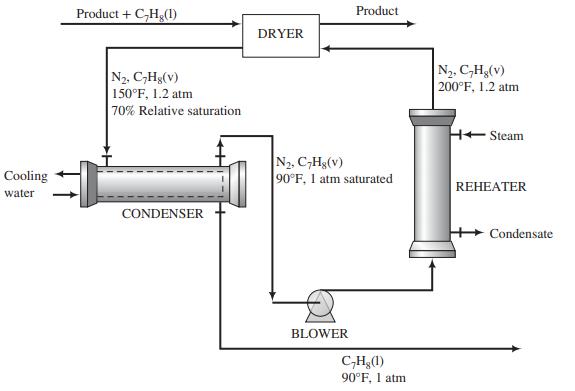In the final stage of the manufacturing process for a solid organic product, the product is cleaned
Question:
In the final stage of the manufacturing process for a solid organic product, the product is cleaned with liquid toluene and then dried in a process whose flowchart is shown on the next page.
The wet product enters the dryer at a rate of 300 lbm=h containing 0:200 lbm toluene/lbm dry solids. A stream of nitrogen at 200°F, 1.2 atm, and containing a small amount of toluene vapor also enters the dryer. (A higher temperature would cause the product to soften and degrade.) Heat is transferred in the dryer from the gas to the wet solids, causing most of the toluene to evaporate. The final product contains 0.020 lbm toluene/lbm dry solids. Gas leaves the dryer at 150°F and 1.2 atm with a relative saturation of 70% and passes through a water-cooled condenser. Gas and liquid streams leave the condenser in equilibrium at 90°F and 1 atm. The gas is reheated to 200°F and reenters the dryer.
(a) Briefly explain this process in your own words. In your explanation, include the purposes of the condenser and the nitrogen reheater and a likely reason that nitrogen rather than air is used as the recirculating gas. What do you suppose happens to the liquid toluene leaving the condenser?

(b) Calculate the compositions (component mole fractions) of the gas streams entering and leaving the dryer, the circulation rate of dry nitrogen (lbm/h), and the volumetric flow rate of gas entering the dryer (ft3/h).
(c) Explain why the actual process has a small make-up nitrogen stream blended with the feed to the blower.
Step by Step Answer:

Elementary Principles of Chemical Processes
ISBN: 978-1119498759
4th edition
Authors: Richard M. Felder, Ronald W. Rousseau, Lisa G. Bullard





